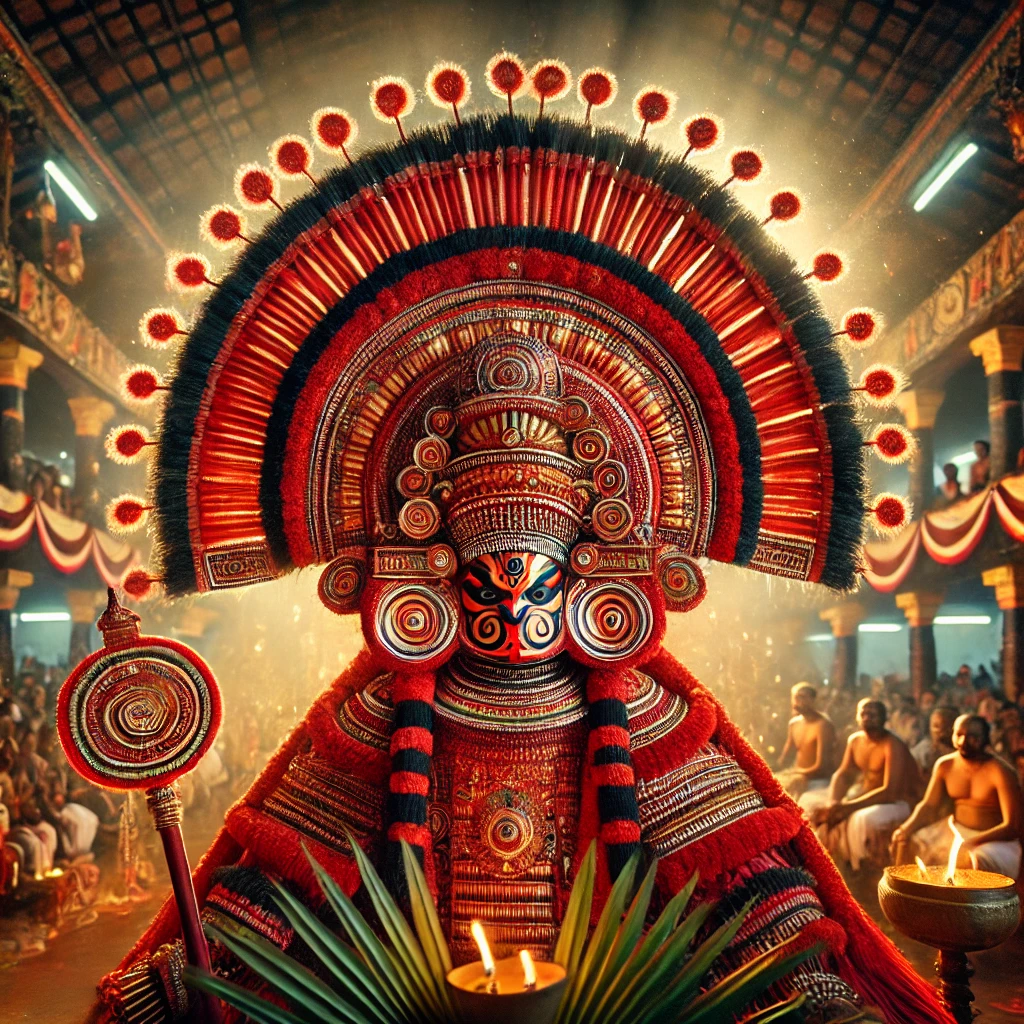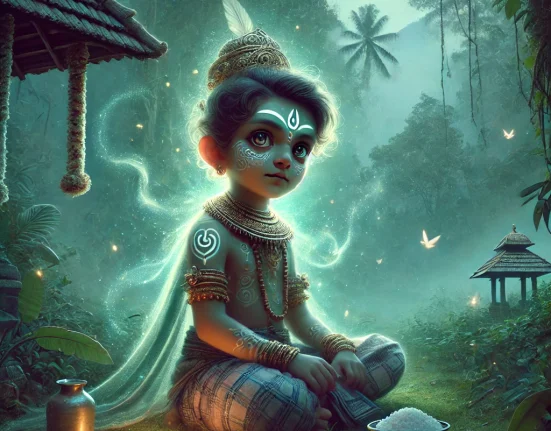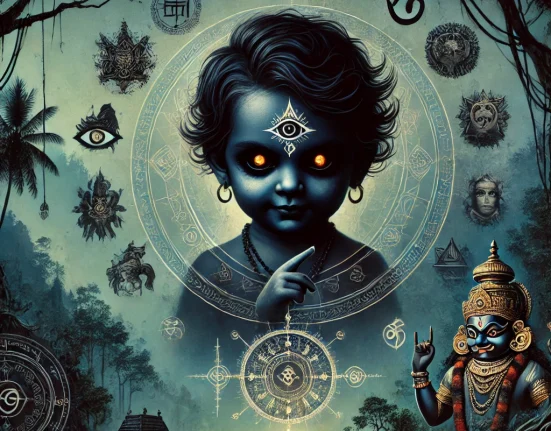Kuttichathan. Particularly significant in the spiritual practices and cultural heritage of Kerala, Kuttichathan is a name that evokes intrigue, reverence, and at times, caution. Often associated with protection, mischief, and powerful Theyyam rituals, the Kuttichathan figures prominently in both ritualistic worship and folktales.
In this guide, we’ll explore the various types of Kuttichathan and their roles in Theyyam, the ancient form of ritual worship through dance and performance art. Let’s delve deeper into the mystical world of Kuttichathan, uncovering the meanings behind each type, and discussing their unique importance in Hinduism.
What is Kuttichathan?
Kuttichathan, often referred to as a mischievous yet powerful deity in Hindu folklore, is commonly invoked through Theyyam performances in Kerala. The term “Kuttichathan” roughly translates to “small spirit,” representing an impish, child-like deity associated with both benevolent and mischievous energies. In the pantheon of Hindu mythology, Kuttichathan holds a unique place, straddling the boundary between divine power and earthy humor. His presence is called upon for protection, fertility, and in some cases, retribution.
Different types of Kuttichathan are depicted in Theyyam rituals, each with distinct characteristics and purposes. These Theyyams are captivating portrayals, embodying the essence of each Kuttichathan type through elaborate costumes, intricate face painting, and hypnotic dance movements.
Types of Kuttichathan
1. Karim Kuttichathan
- Description: Known as the “Black Kuttichathan,” Karim Kuttichathan is among the most revered and feared of the Kuttichathan types. His appearance is marked by dark hues, symbolizing power and mystery.
- Significance: Karim Kuttichathan is believed to wield immense power over dark forces. He is summoned during Theyyam rituals to protect communities from malevolent spirits or dark energies. Devotees approach Karim Kuttichathan for help with overcoming personal fears, seeking strength, and safeguarding their homes.
- Cultural Impact: The Karim Kuttichathan Theyyam is one of the most popular Theyyams performed during festivals, with many devotees observing the rituals as a form of spiritual cleansing.
2. Poo Kuttichathan
- Description: Poo Kuttichathan, or the “Flower Kuttichathan,” is depicted with vibrant floral decorations that represent purity, beauty, and growth.
- Significance: Unlike Karim Kuttichathan, who is associated with power and mystery, Poo Kuttichathan embodies innocence and positivity. His presence is invoked to bless the land with fertility and abundance, making him especially popular among farmers and those in agrarian communities.
- Cultural Impact: The Poo Kuttichathan Theyyam performance often incorporates floral offerings, symbolizing renewal and growth. Devotees believe that watching this Theyyam brings good luck, particularly in matters of health and prosperity.
3. Thee Kuttichathan
- Description: Known as the “Fire Kuttichathan,” Thee Kuttichathan represents fiery energy and transformation.
- Significance: He is invoked to cleanse areas of negative energy and is particularly revered in rituals aimed at purifying homes, villages, or agricultural land.
- Cultural Impact: The Thee Kuttichathan Theyyam performance is visually stunning, with performers donning fiery red and orange attire. It’s a dramatic representation, often involving fire, that symbolizes the triumph of purity over impurity.
4. Poothan Kuttichathan
- Description: Poothan Kuttichathan is often depicted as a terrifying figure adorned in bold, fearsome makeup.
- Significance: He represents both protection and punishment, believed to guard devotees while also being capable of exacting justice when invoked against wrongdoers.
- Cultural Impact: Poothan Kuttichathan is celebrated for his protective qualities, particularly in households. The Poothan Kuttichathan Theyyam performance often includes enactments of his judgment, reminding spectators of the thin line between blessing and retribution.
5. Chamundi Kuttichathan
- Description: Chamundi Kuttichathan draws his name from the fierce goddess Chamundi, known for her strength and protective powers.
- Significance: Associated with feminine power, Chamundi Kuttichathan is called upon by those seeking strength, resilience, and empowerment. His energy is said to protect the vulnerable and empower those facing challenges.
- Cultural Impact: In Theyyam rituals, Chamundi Kuttichathan is especially revered among female devotees, who seek blessings for personal courage and resilience. The performance often embodies the qualities of strength and defiance against obstacles.
6. Muthor Theyyam
- Description: Representing the unity of multiple divine energies, Muthor Theyyam is a powerful representation of collective strength.
- Significance: Muthor Theyyam is invoked for communal harmony and well-being. Devotees believe that his blessings bring collective prosperity, success, and peace.
- Cultural Impact: The Muthor Theyyam ceremony is grand, with rituals symbolizing the coming together of the community in shared beliefs and mutual respect.
7. Raktha Chamundi Kuttichathan
- Description: As a fierce embodiment of Chamundi, Raktha Chamundi Kuttichathan is symbolized with red motifs, representing blood and life force.
- Significance: Known for his aggressive protective nature, he is sought out in Theyyam rituals to ward off malevolent entities and safeguard communities from calamities.
- Cultural Impact: The Raktha Chamundi Kuttichathan Theyyam involves intense performances and blood-red costumes, symbolizing vitality and life.
8. Kari Chamundi Kuttichathan
- Description: Kari Chamundi Kuttichathan embodies a form of Chamundi associated with powerful feminine energy.
- Significance: Devotees, particularly women, look to Kari Chamundi Kuttichathan for inner strength, courage, and protection.
- Cultural Impact: His Theyyam performance is a spectacle of divine femininity, with costumes and dance moves reflecting grace and unyielding strength.
9. Karimbana Kuttichathan
- Description: Known for his association with forests and nature, Karimbana Kuttichathan is invoked for blessings related to natural resources and environmental health.
- Significance: Farmers and environmental enthusiasts look up to Karimbana Kuttichathan for agricultural prosperity and ecological balance.
- Cultural Impact: The Karimbana Kuttichathan Theyyam ceremony often includes elements of nature, reinforcing the need to preserve the environment.
10. Vellattam Kuttichathan
- Description: As an earlier stage of the Kuttichathan Theyyam performance, Vellattam Kuttichathan acts as a precursor ritual.
- Significance: Vellattam Kuttichathan sets the stage, invoking blessings to ensure that the ensuing rituals unfold without obstacles.
- Cultural Impact: This type is fundamental, marking the beginning of the ritual journey.
11. Kandakarnan Kuttichathan
- Description: Associated with vigilance, Kandakarnan Kuttichathan is worshipped for his protective qualities.
- Significance: He watches over devotees, providing a spiritual guard against unseen threats.
- Cultural Impact: His Theyyam performance is revered for bringing mental clarity and a heightened sense of security.
Conclusion
The Kuttichathan Theyyam rituals are more than just elaborate performances; they represent the complex relationship between humanity and divinity. Through each type of Kuttichathan, devotees are reminded of the balance between protection and retribution, innocence and power, tradition and change. As you observe or participate in these Theyyam rituals, consider the broader cultural context and the deep reverence in each performance—a reminder of the rich, enduring cultural and spiritual legacy of Hindu beliefs.




Leave feedback about this